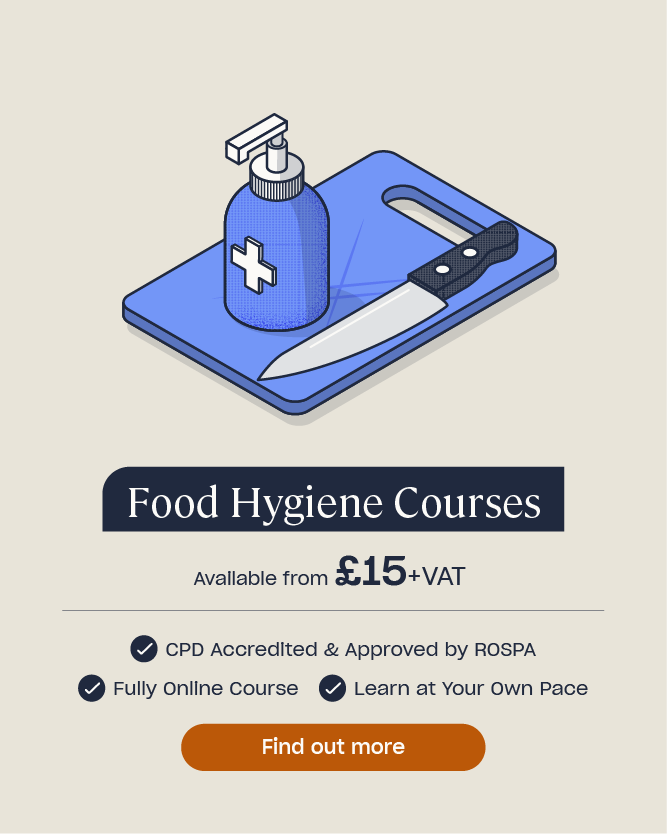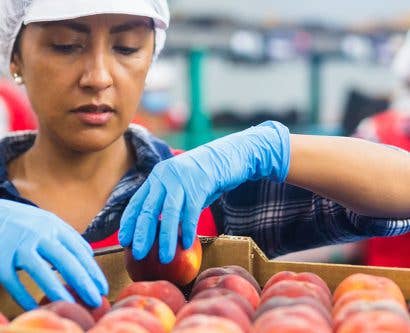4 Common Kitchen Hazards and How to Avoid Them
When you’re busy trying to get dishes out the door, it’s easy to overlook kitchen hazards. But a hectic kitchen makes you more vulnerable to risks, so you must keep hazards at the forefront of your mind. Reducing hazards to a minimum allows you and your co-workers to stay safe, work at full efficiency, and provide your diners with top quality service.
Common Kitchen Hazards
Hazards in commercial kitchens often relate to food preparation equipment, manual handling, the way stock is stored, and the cleanliness of the environment.
But in truth, most if not all hazards are created by people.
If you work in accordance with your food handler’s safety training and the prevention measures discussed below, you’ll cut hazards down to a safe minimum.
1. Manual handling
Carrying, lifting, pushing, and other manual handling manoeuvres can, if not done safely, seriously harm the body’s musculoskeletal system.
The Health and Safety Executive reports that over 30% of food and drink industry injuries are mainly musculoskeletal injuries caused by manual handling.
Hazardous manual handling tasks include:
- Lifting boxes and crates of food.
- Pushing or pulling wheeled racks (such as trolleys).
- Carrying pots or stacks of plates.
- Moving equipment.
- Handing containers of drinks (including casks and kegs).
- Unloading food and drink deliveries.
- Cutting and deboning (meat and poultry).
- Reaching for items on shelves or in walk-in fridges.
Manoeuvring awkward loads with contents that shift, like casks and kegs, are especially risky, as you usually have to adjust your grip on the move to minimise strain.
To minimise manual handling hazards, you should:
- Keep the load close to your body, with the heaviest side facing yourself.
- Get a good grip of the load and adopt a stable position.
- Know your limits – if a load is too strenuous, don’t push yourself. Loads should never exceed 25kg.
- Adopt a good posture – keep your back straight and avoid twisting or leaning.
- Clear away obstacles or wet patches on the route beforehand.
- Make use of manual handling equipment, such as trolleys and keg trucks. Be sure to follow their instructions for safe use.
If your job involves a great deal of lifting and carrying, your employer should provide you with manual handling training, which should fully cover proper techniques.

2. Slips, trips, and falls
Kitchens often have numerous slip, trip, and fall risks created by human error, meaning you and others need to focus closely on proper safety practices and housekeeping.
Slip, trip, and fall hazards include:
- Floor contamination, such as spillages of water, sauces, oil, and flour.
- Wet floors from cleaning.
- Obstructions in walkways, including trailing cables, boxes and crates, bins, cleaning equipment, etc.
- Uneven, worn down, or loose flooring.
- Using a ladder to access high pantry shelves.
- Standing in a truck to unload deliveries.
Preventing floor contamination is critical as people are constantly moving around on their feet, sometimes while transporting hot food that could spill onto them if they fell.
To minimise slip, trip, and fall hazards, you should:
- Carry out good housekeeping – clean spillages and move obstructions out of walkways right away.
- Take extra care while cleaning – avoid leaving puddles behind and make sure the cleaning materials you’re using are correct for the type of floor in your kitchen. Dry mop where possible to eliminate slip risks altogether.
- Keep cables out of walkways – use the nearest plug socket for appliances.
- Report any issues with the flooring or work activities that are generating hazards when they shouldn’t, for example leaking equipment.
- Use ladders in accordance with safety instructions – rest ladders on a firm, level surface and only use them for up to 30 minutes. Do not lift more than 10kg up a ladder.
- Avoid accessing heights without a suitable ladder – chairs and shelves are unsafe to stand on.
- Carry out deliveries with a co–worker – working with someone minimises the amount of times you have to step on and off the back of a truck and put yourself at risk of falling.

3. Improper storage
If not properly stored in shelves and fridges, objects could fall from height onto people, while food could become unsafe to use over time.
To store correctly, you should:
- Store heavy items no higher than waist height and don’t overstock shelves.
- Use a FIFO food storage system.
- Use a stepladder if you must access higher shelves, so you don’t have to reach above your head. Follow ladder safety rules.
- Follow your food safety and hygiene training.
- Know how to store food in the fridge safely: ready-to-eat food on the top; raw meat, poultry, and fish on the bottom; and fruits and veg in the bottom drawer. Keep food in containers for further separation, and don’t overload the fridge.
- Check best before and use-by dates on stock regularly.
- Keep allergenic ingredients well away from non-allergenic ones.
- Ensure the temperature of the fridge is between 0-5°c and the freezer is below -18°c.

4. Fire and electrical hazards
You regularly use electrical equipment and naked flames in a kitchen. Fire and electricity are serious dangers; they can cause burns and shocks or even ignite a fire.
To minimise fire and electrical hazards, you should:
- Keep an eye out for sources of ignition and fuel – remove cardboard boxes, packaging, and flour (with wet cleaning to prevent creating a combustible cloud).
- Take extreme care when working around naked flames or electric stoves – keep flammable materials away from sources of heat and remember to wear a suitable chef’s jacket.
- Check appliances and equipment’s cables and plugs for signs of damage – such as fraying, dents, cracks, exposed wires, or burn marks. Also listen out for any unusual sounds.
- Clean up spilled chemicals immediately – use-non-flammable materials to do so.
- Use electrical equipment and appliances only for their intended purpose – follow all training provided to you.
- Keep electrical appliances away from water and do not overload socket outlets.
- Never attempt to repair electrical equipment yourself – if it appears faulty or has stopped working, take it out of use and report it to senior staff ASAP.
- Turn off all electrical equipment, stoves, and ovens at the end of the work day and when cleaning.

These lists of kitchen hazards and preventative measures are far from exhaustive, but they give you useful know-how for preventing the most common dangers you might face in a commercial kitchen and they increase your awareness. Your safety-conscious mind-set will help you spot all types of hazards while at work.
What to Read Next:
- Health and Safety in the Kitchen Quiz
- What is a “Clean As You Go” Policy?
- How to Prepare for an EHO Visit
- Slips, Trips and Falls Quiz
- How to Avoid Electrical Hazards at Work
- A Short Guide to Ventilation in Commercial Kitchens
- Kitchen Risk Assessment Template for Catering










